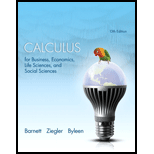
Problems 91–94 refer to the following: If a decrease in demand for one product results in an increase in demand for another product, the two products are said to be competitive, or substitute,
products. (Real whipping cream and imitation whipping cream are examples of competitive, or substitute, products.) If a decrease in demand for one product results in a decrease in demand for another product, the two products are said to be complementary products. (Fishing boats and outboard motors are examples of complementary products.) Partial derivatives can be used to test whether two products are competitive, complementary, or neither. We start with demand functions for two products such that the demand for either depends on the prices for both:
The variables x and y represent the number of units demanded of products A and B, respectively, at a price p for 1 unit of product A and a price q for I unit of product B. Normally, if the price of A increases while the price of B is held constant, then the demand for A will decrease; that is, fp(p, q) < 0. Then, if A and B are competitive products, the demand for B will increase; that is, gr(p, q) > 0. Similarly, if the price of B increases while the price of A is held constant, the demand for B will decrease; that is, gq(p, q) < 0. Then, if A and B are competitive products, the demand for A will increase; that is, fq(p, q) > 0. Reasoning similarly for complementary products, we arrive at the following test:
Test for Competitive and Complementary Products
| Partial Derivatives | Products A and B |
| fq(p, q) > and gp(p, q) > 0 | Competitive (substitute) |
| fq(p, q) < and gp(p, q) < 0 | Complementary |
| fq(p, q) ≥ and gp(p, q) ≤ 0 | Neither |
| fq(p, q) ≤ and gp(p, q) ≥ 0 | Neither |
Use this test in Problems 91-94 to determine whether the indicated products are competitive, complementary, or neither.
94. Product demand. The monthly demand equations for the sale of tennis rackets and tennis balls in a sporting goods store are
Want to see the full answer?
Check out a sample textbook solution
Chapter 7 Solutions
Calculus for Business, Economics, Life Sciences, and Social Sciences (13th Edition)
- T Teenage obesity (O), and weekly fast-food meals (F), among some selected Mississippi teenagers are: Name Obesity (lbs) # of Fast-foods per week Josh 185 10 Karl 172 8 Terry 168 9 Kamie Andy 204 154 12 6 (a) Compute the variance of Obesity, s²o, and the variance of fast-food meals, s², of this data. [Must show full work]. (b) Compute the Correlation Coefficient between O and F. [Must show full work]. (c) Find the Coefficient of Determination between O and F. [Must show full work]. (d) Obtain the Regression equation of this data. [Must show full work]. (e) Interpret your answers in (b), (c), and (d). (Full explanations required). Edit View Insert Format Tools Tablearrow_forwardH.w WI M Wz dy A Sindax Sind ①dlmax У тах at 0.75m from A W=6KN/M L=2 W2 = 9 KN/m P= 10 KN Barrow_forwardNo chatgpt pls will upvotearrow_forward
- Q4*) Find the extremals y, z of the the functional 1 = √² (2yz — 2z² + y² — z¹²) dx, - - with y(0) = 0, y(1) = 1, z(0) = 0, z(1) = 0.arrow_forwardlet h0, h1, h2,..., hn,....be the sequence defined by hn = (n C 2), (n choose 2). (n>=0). Determine the generating function for the sequence.arrow_forwardDraw the triangle and show all the workarrow_forward
- The average miles per gallon for a sample of 40 cars of model SX last year was 32.1, with a population standard deviation of 3.8. A sample of 40 cars from this year’s model SX has an average of 35.2 mpg, with a population standard deviation of 5.4. Find a 99 percent confidence interval for the difference in average mpg for this car brand (this year’s model minus last year’s).Find a 99 percent confidence interval for the difference in average mpg for last year’s model minus this year’s. What does the negative difference mean?arrow_forwardA special interest group reports a tiny margin of error (plus or minus 0.04 percent) for its online survey based on 50,000 responses. Is the margin of error legitimate? (Assume that the group’s math is correct.)arrow_forwardSuppose that 73 percent of a sample of 1,000 U.S. college students drive a used car as opposed to a new car or no car at all. Find an 80 percent confidence interval for the percentage of all U.S. college students who drive a used car.What sample size would cut this margin of error in half?arrow_forward
- You want to compare the average number of tines on the antlers of male deer in two nearby metro parks. A sample of 30 deer from the first park shows an average of 5 tines with a population standard deviation of 3. A sample of 35 deer from the second park shows an average of 6 tines with a population standard deviation of 3.2. Find a 95 percent confidence interval for the difference in average number of tines for all male deer in the two metro parks (second park minus first park).Do the parks’ deer populations differ in average size of deer antlers?arrow_forwardSuppose that you want to increase the confidence level of a particular confidence interval from 80 percent to 95 percent without changing the width of the confidence interval. Can you do it?arrow_forwardA random sample of 1,117 U.S. college students finds that 729 go home at least once each term. Find a 98 percent confidence interval for the proportion of all U.S. college students who go home at least once each term.arrow_forward
 Linear Algebra: A Modern IntroductionAlgebraISBN:9781285463247Author:David PoolePublisher:Cengage Learning
Linear Algebra: A Modern IntroductionAlgebraISBN:9781285463247Author:David PoolePublisher:Cengage Learning

